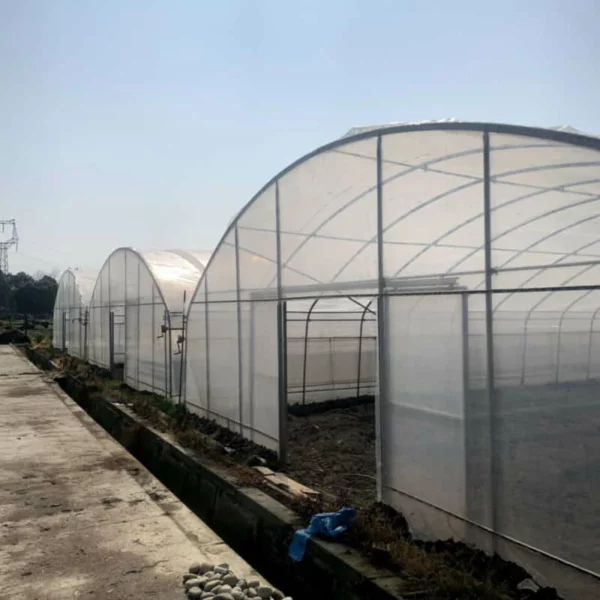Single-span greenhouses are compact structures that provide controlled environments for crop cultivation. These greenhouses consist of a single span or bay, offering a simplified and efficient solution for growers. In this article, we will explore the features and role of single-span greenhouses, highlighting their contributions to crop production, versatility, and resource optimization in controlled agricultural systems
nt to note that the suitability of crops for single-span greenhouses may vary depending on factors such as regional climate, available resources, and market demand. Growers can select crops based on their specific goals, market preferences, and the adaptability of different crop varieties to greenhouse conditions.
Understanding Single-Span Greenhouses
- Structure and Design:Single-span greenhouses are characterized by their singular, uninterrupted span that houses the growing area. These structures typically feature a sturdy framework made of materials such as galvanized steel or aluminum, providing structural stability and support. The covering material, often translucent polyethylene or polycarbonate, allows for the transmission of natural sunlight while insulating the interior.
- Compact and Efficient Design:Single-span greenhouses are designed to maximize space utilization and operational efficiency. With a single span, these structures are comparatively smaller in size and footprint, making them suitable for limited space availability or smaller-scale operations. The compact design facilitates ease of installation, maintenance, and management.
The Role of Single-Span Greenhouses
- Crop Production and Protection:Single-span greenhouses play a vital role in creating controlled environments for crop production. By providing a shield from external climatic factors, these structures enable growers to cultivate crops in regions with unfavorable weather conditions or extend the growing season in colder climates. The controlled environment inside the greenhouse contributes to improved crop quality, enhanced yields, and protection against pests, diseases, and extreme weather events.
- Versatility in Crop Cultivation:Single-span greenhouses offer versatility in crop selection and cultivation. Growers can tailor the greenhouse conditions, such as temperature, humidity, and light levels, to meet the specific requirements of various crops. This flexibility allows for the cultivation of a wide range of plants, including vegetables, herbs, flowers, and specialty crops, throughout the year. Single-span greenhouses are particularly valuable for small-scale and niche growers seeking to produce high-value or unique crops.
- Resource Optimization:Single-span greenhouses contribute to efficient resource utilization. The compact size of these structures reduces the overall resource requirements, such as water, fertilizers, and energy. Growers can achieve precise control over irrigation systems, nutrient delivery, and climate management, minimizing waste and maximizing resource efficiency. Additionally, single-span greenhouses can be equipped with energy-saving technologies, such as insulation, shading systems, and efficient ventilation, further enhancing resource optimization.
- Research and Education:Single-span greenhouses play a significant role in research and educational settings. These structures provide controlled environments for conducting experiments, studying plant physiology, and developing innovative growing techniques. They are also valuable tools for educational institutions, allowing students to gain hands-on experience in horticulture, agronomy, and plant sciences. Single-span greenhouses facilitate experiential learning and foster innovation in controlled agricultural practices.
- Accessibility and Affordability:Single-span greenhouses offer a more accessible and affordable option for growers, particularly those with limited resources or space constraints. The compact design, ease of installation, and lower initial investment make single-span greenhouses a viable choice for small-scale farmers, urban gardens, or community initiatives. These structures enable a broader range of individuals to engage in controlled agriculture and contribute to local food production.
Can you provide examples of crops that are commonly grown in single-span greenhouses?
Single-span greenhouses are versatile structures that can accommodate a wide range of crops. Here are some examples of crops commonly grown in single-span greenhouses:
- Leafy Greens: Crops like lettuce, spinach, kale, and Swiss chard thrive in the controlled environment of single-span greenhouses. The ability to regulate temperature, humidity, and light levels allows for optimal growth and high-quality leafy greens.
- Herbs: Many herbs, including basil, parsley, cilantro, mint, and rosemary, are well-suited for cultivation in single-span greenhouses. The controlled conditions help maintain consistent growth and flavor profiles, making them ideal for culinary and medicinal herb production.
- Tomatoes: Single-span greenhouses provide excellent conditions for growing tomatoes. The controlled environment helps extend the growing season, protect against diseases, and optimize fruit development. Both standard and cherry tomato varieties can be successfully cultivated in these structures.
- Cucumbers: Cucumbers are another popular crop for single-span greenhouses. The controlled environment allows for optimal temperature and humidity levels, promoting vigorous vine growth and high yields of quality cucumbers.
- Peppers: Bell peppers and chili peppers can thrive in single-span greenhouses. The ability to regulate temperature and provide consistent growing conditions ensures healthy plant development and a productive pepper harvest.
- Strawberries: Single-span greenhouses can create an ideal environment for strawberry production. The controlled conditions help extend the growing season, protect against pests, and provide optimum light and temperature, resulting in flavorful and high-yielding strawberries.
- Flowers: Many flower varieties, such as roses, gerbera daisies, and chrysanthemums, can be cultivated in single-span greenhouses. The controlled environment allows for precise management of light, temperature, and humidity, facilitating optimal growth and longer vase life.
- Microgreens: Single-span greenhouses are well-suited for microgreen production. These young, nutrient-dense greens are harvested at an early stage and are popular in culinary applications. The controlled conditions inside single-span greenhouses support rapid and consistent growth of microgreens.
- Specialty Crops: Single-span greenhouses are often utilized for growing specialty crops like exotic vegetables, unique herbs, or heirloom varieties. These structures provide the flexibility to create specific microclimates, enabling the successful cultivation of rare or high-value crops.
Single-span greenhouses provide compact, efficient, and versatile solutions for controlled crop production. Their role in enhancing crop productivity,single-span greenhouses optimizing resources, and supporting research and education is significant. By harnessing the benefits of single-span greenhouses, farmers, educators, and small-scale growers can create controlled environments that contribute to sustainable agriculture, food security, and innovation in the field of horticulture

